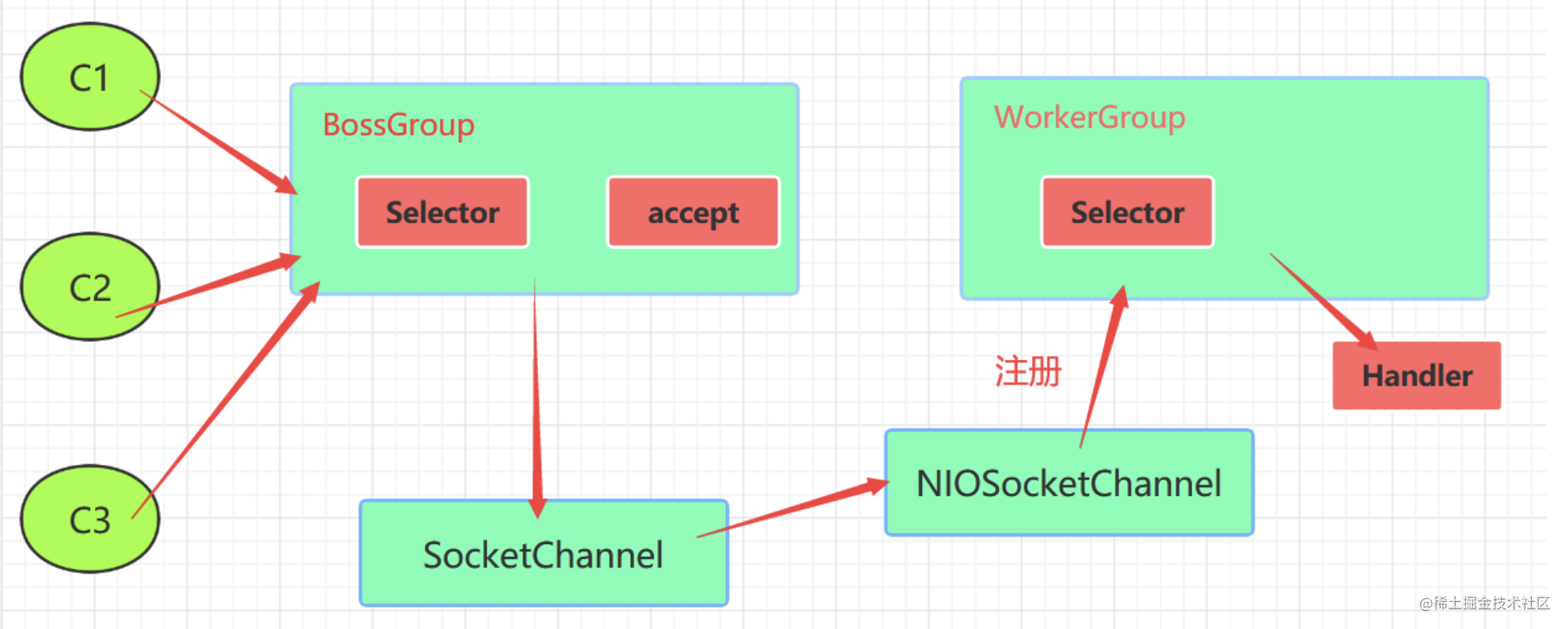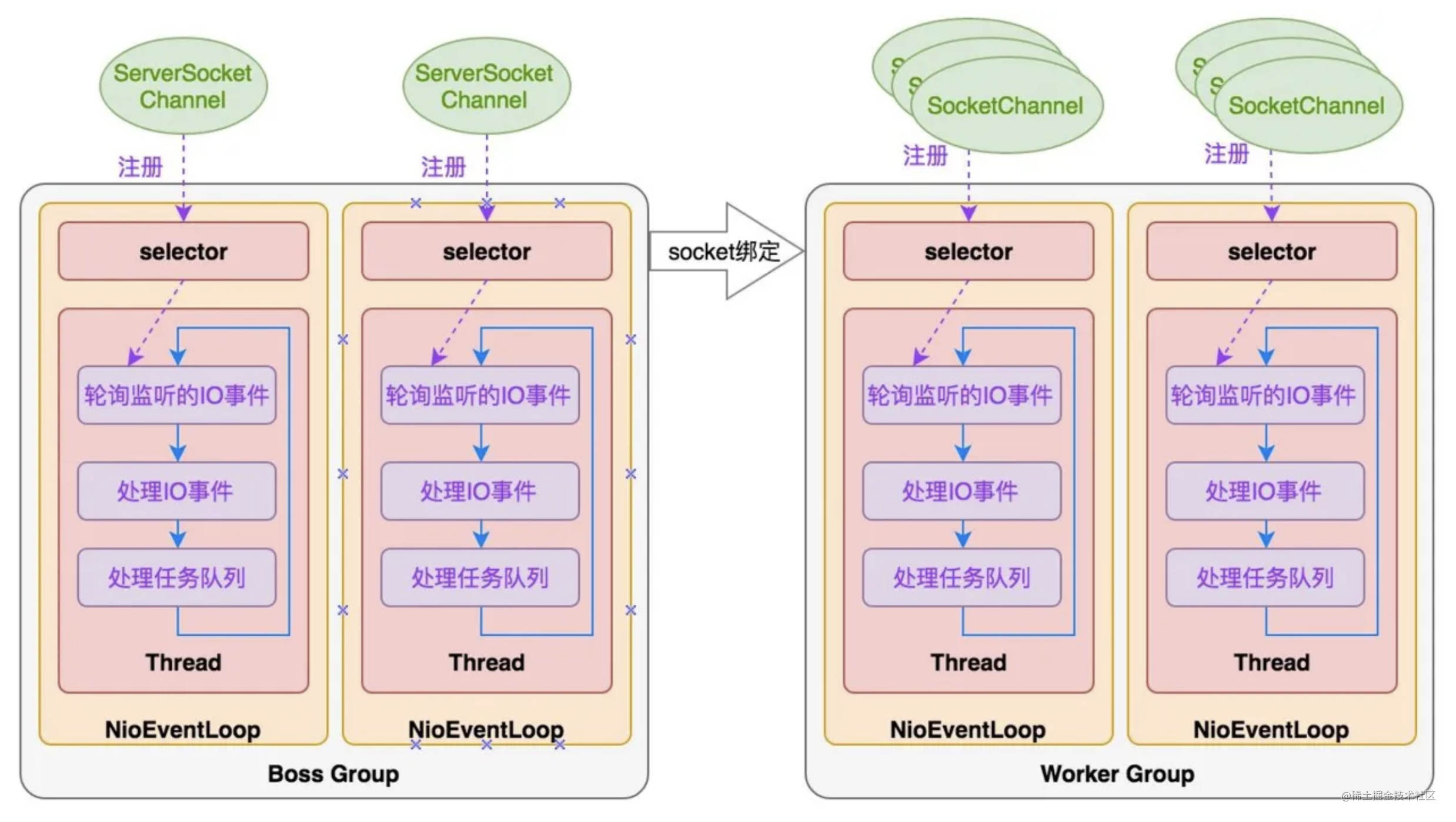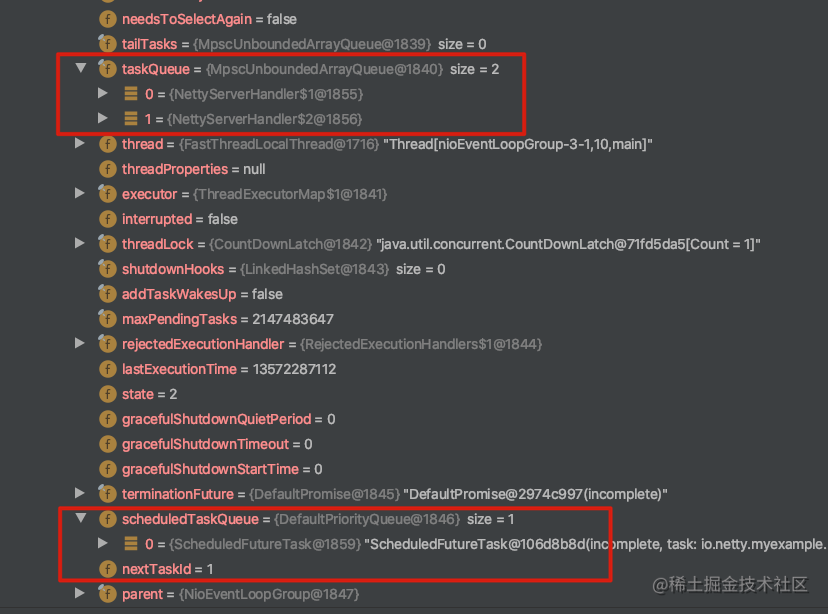欢迎大家关注 github.com/hsfxuebao ,希望对大家有所帮助,要是觉得可以的话麻烦给点一下Star哈
阅读本篇文章,必须有Reactor模型的基础,详见IO系列4-由浅入深Reactor和Proactor模式。
1. Netty线程模型
1.1 工作原理示意图
Netty 主要基于主从 Reactors 多线程模型(如图)做了一定的改进,其中主从 Reactor 多线程模型有多个 Reactor。

对图中进行说明:
- BossGroup 线程维护Selector , 只关注Accecpt
- 当接收到Accept事件,获取到对应的SocketChannel, 封装成 NIOScoketChannel并注册到Worker 线程(事件循环), 并进行维护
- 当Worker线程监听到selector 中通道发生自己感兴趣的事件后,就进行处理(就由handler), 注意handler 已经加入到通道,如图:

详细图如下:
 说明如下:
说明如下:
-
Netty抽象出两组线程池: BossGroup 专门负责接收客户端的连接, WorkerGroup 专门负责网络的读写。BossGroup 和 WorkerGroup 类型都是 NioEventLoopGroup
-
NioEventLoopGroup 相当于一个事件循环组, 这个组中含有多个事件循环 ,每一个事件循环是 NioEventLoop
-
NioEventLoop 表示一个不断循环的执行处理任务的线程, 每个NioEventLoop 都有一个selector , 用于监听绑定在其上的socket的网络通讯
-
NioEventLoopGroup 可以有多个线程, 即可以含有多个NioEventLoop
-
每个Boss NioEventLoop 循环执行的步骤有3步
- 轮询accept 事件
- 处理accept 事件 , 与client建立连接 , 生成NioScocketChannel , 并将其注册到某个worker NIOEventLoop 上的 selector
- 处理任务队列的任务 , 即 runAllTasks
-
每个 Worker NIOEventLoop 循环执行的步骤
- 轮询read, write 事件
- 处理i/o事件, 即read , write 事件,在对应NioScocketChannel 处理
- 处理任务队列的任务 , 即 runAllTasks
-
每个Worker NIOEventLoop 处理业务时,会使用pipeline(管道), pipeline 中包含了 channel , 即通过pipeline 可以获取到对应通道, 管道中维护了很多的 处理器
2. Netty简单使用
2.1 Netty快速入门实例-TCP服务
实例要求:使用IDEA 创建Netty项目
Netty 服务器在 6668 端口监听,客户端能发送消息给服务器 "hello, 服务器~"
服务器可以回复消息给客户端 "hello, 客户端~"
目的:对Netty 线程模型 有一个初步认识, 便于理解Netty 模型理论
NettyServer
public class NettyServer {
public static void main(String[] args) throws Exception {
//创建BossGroup 和 WorkerGroup
//说明
//1. 创建两个线程组 bossGroup 和 workerGroup
//2. bossGroup 只是处理连接请求 , 真正的和客户端业务处理,会交给 workerGroup完成
//3. 两个都是无限循环
//4. bossGroup 和 workerGroup 含有的子线程(NioEventLoop)的个数
// 默认实际 cpu核数 * 2
EventLoopGroup bossGroup = new NioEventLoopGroup(1);
EventLoopGroup workerGroup = new NioEventLoopGroup(); //8
try {
//创建服务器端的启动对象,配置参数
ServerBootstrap bootstrap = new ServerBootstrap();
//使用链式编程来进行设置
bootstrap.group(bossGroup, workerGroup) //设置两个线程组
.channel(NioServerSocketChannel.class) //使用NioSocketChannel 作为服务器的通道实现
.option(ChannelOption.SO_BACKLOG, 128) // 设置线程队列得到连接个数
.childOption(ChannelOption.SO_KEEPALIVE, true) //设置保持活动连接状态
// .handler(null) // 该 handler对应 bossGroup , childHandler 对应 workerGroup
.childHandler(new ChannelInitializer<SocketChannel>() { //创建一个通道初始化对象(匿名对象)
//给pipeline 设置处理器
@Override
protected void initChannel(SocketChannel ch) throws Exception {
System.out.println("客户socketchannel hashcode=" + ch.hashCode()); //可以使用一个集合管理 SocketChannel, 再推送消息时,可以将业务加入到各个channel 对应的 NIOEventLoop 的 taskQueue 或者 scheduleTaskQueue
ch.pipeline().addLast(new NettyServerHandler());
}
}); // 给我们的workerGroup 的 EventLoop 对应的管道设置处理器
System.out.println(".....服务器 is ready...");
//绑定一个端口并且同步, 生成了一个 ChannelFuture 对象
//启动服务器(并绑定端口)
ChannelFuture cf = bootstrap.bind(6668).sync();
//给cf 注册监听器,监控我们关心的事件
cf.addListener(new ChannelFutureListener() {
@Override
public void operationComplete(ChannelFuture future) throws Exception {
if (cf.isSuccess()) {
System.out.println("监听端口 6668 成功");
} else {
System.out.println("监听端口 6668 失败");
}
}
});
//对关闭通道进行监听
cf.channel().closeFuture().sync();
} finally {
bossGroup.shutdownGracefully();
workerGroup.shutdownGracefully();
}
}
}
/**
说明
1. 我们自定义一个Handler 需要继承netty 规定好的某个HandlerAdapter(规范)
2. 这时我们自定义一个Handler , 才能称为一个handler
*/
public class NettyServerHandler extends ChannelInboundHandlerAdapter {
//读取数据实际(这里我们可以读取客户端发送的消息)
/*
1. ChannelHandlerContext ctx:上下文对象, 含有 管道pipeline , 通道channel, 地址
2. Object msg: 就是客户端发送的数据 默认Object
*/
@Override
public void channelRead(ChannelHandlerContext ctx, Object msg) throws Exception {
System.out.println("服务器读取线程 " + Thread.currentThread().getName() + " channel =" + ctx.channel());
System.out.println("server ctx =" + ctx);
System.out.println("看看channel 和 pipeline的关系");
Channel channel = ctx.channel();
ChannelPipeline pipeline = ctx.pipeline(); //本质是一个双向链接, 出站入站
//将 msg 转成一个 ByteBuf
//ByteBuf 是 Netty 提供的,不是 NIO 的 ByteBuffer.
ByteBuf buf = (ByteBuf) msg;
System.out.println("客户端发送消息是:" + buf.toString(CharsetUtil.UTF_8));
System.out.println("客户端地址:" + channel.remoteAddress());
}
//数据读取完毕
@Override
public void channelReadComplete(ChannelHandlerContext ctx) throws Exception {
//writeAndFlush 是 write + flush
//将数据写入到缓存,并刷新
//一般讲,我们对这个发送的数据进行编码
ctx.writeAndFlush(Unpooled.copiedBuffer("hello, 客户端~(>^ω^<)喵1", CharsetUtil.UTF_8));
}
//处理异常, 一般是需要关闭通道
@Override
public void exceptionCaught(ChannelHandlerContext ctx, Throwable cause) throws Exception {
ctx.close();
}
}
NettyClient
public class NettyClient {
public static void main(String[] args) throws Exception {
//客户端需要一个事件循环组
EventLoopGroup group = new NioEventLoopGroup();
try {
//创建客户端启动对象
//注意客户端使用的不是 ServerBootstrap 而是 Bootstrap
Bootstrap bootstrap = new Bootstrap();
//设置相关参数
bootstrap.group(group) //设置线程组
.channel(NioSocketChannel.class) // 设置客户端通道的实现类(反射)
.handler(new ChannelInitializer<SocketChannel>() {
@Override
protected void initChannel(SocketChannel ch) throws Exception {
ch.pipeline().addLast(new NettyClientHandler()); //加入自己的处理器
}
});
System.out.println("客户端 ok..");
//启动客户端去连接服务器端
//关于 ChannelFuture 要分析,涉及到netty的异步模型
ChannelFuture channelFuture = bootstrap.connect("127.0.0.1", 6668).sync();
//给关闭通道进行监听
channelFuture.channel().closeFuture().sync();
} finally {
group.shutdownGracefully();
}
}
}
public class NettyClientHandler extends ChannelInboundHandlerAdapter {
//当通道就绪就会触发该方法
@Override
public void channelActive(ChannelHandlerContext ctx) throws Exception {
System.out.println("client " + ctx);
ctx.writeAndFlush(Unpooled.copiedBuffer("hello, server: (>^ω^<)喵", CharsetUtil.UTF_8));
}
//当通道有读取事件时,会触发
@Override
public void channelRead(ChannelHandlerContext ctx, Object msg) throws Exception {
ByteBuf buf = (ByteBuf) msg;
System.out.println("服务器回复的消息:" + buf.toString(CharsetUtil.UTF_8));
System.out.println("服务器的地址: "+ ctx.channel().remoteAddress());
}
@Override
public void exceptionCaught(ChannelHandlerContext ctx, Throwable cause) throws Exception {
cause.printStackTrace();
ctx.close();
}
}
NettyServer执行结果:
.....服务器 is ready...
监听端口 6668 成功
客户socketchannel hashcode=422811890
服务器读取线程 nioEventLoopGroup-3-1 channel =[id: 0x53f0ffc3, L:/127.0.0.1:6668 - R:/127.0.0.1:56900]
server ctx =ChannelHandlerContext(NettyServerHandler#0, [id: 0x53f0ffc3, L:/127.0.0.1:6668 - R:/127.0.0.1:56900])
看看channel 和 pipeline的关系
客户端发送消息是:hello, server: (>^ω^<)喵
客户端地址:/127.0.0.1:56900
NettyClient执行结果:
客户端 ok..
client ChannelHandlerContext(NettyClientHandler#0, [id: 0xca6ccb78, L:/127.0.0.1:56900 - R:/127.0.0.1:6668])
服务器回复的消息:hello, 客户端~(>^ω^<)喵1
服务器的地址: /127.0.0.1:6668
2.2 任务队列中的 Task 有 3 种典型使用场景
- 用户程序自定义的普通任务
- 用户自定义定时任务
- 非当前 Reactor 线程调用 Channel 的各种方法
例如在推送系统的业务线程里面,根据用户的标识,找到对应的 Channel 引用,然后调用 Write 类方法向该用户推送消息,就会进入到这种场景。最终的 Write 会提交到任务队列中后被异步消费
其他程序扔使用 2.1 中的代码,只是将NettyServerHandler 更改一下,如下:
public class NettyServerHandler extends ChannelInboundHandlerAdapter {
//读取数据实际(这里我们可以读取客户端发送的消息)
/*
1. ChannelHandlerContext ctx:上下文对象, 含有 管道pipeline , 通道channel, 地址
2. Object msg: 就是客户端发送的数据 默认Object
*/
@Override
public void channelRead(ChannelHandlerContext ctx, Object msg) throws Exception {
//比如这里我们有一个非常耗时长的业务-> 异步执行 -> 提交该channel 对应的
//NIOEventLoop 的 taskQueue中,
//解决方案1 用户程序自定义的普通任务
ctx.channel().eventLoop().execute(new Runnable() {
@Override
public void run() {
try {
Thread.sleep(5 * 1000);
ctx.writeAndFlush(Unpooled.copiedBuffer("hello, 客户端~(>^ω^<)喵2", CharsetUtil.UTF_8));
System.out.println("channel code=" + ctx.channel().hashCode() + "now =" + LocalDateTime.now());
} catch (Exception ex) {
System.out.println("发生异常" + ex.getMessage());
}
}
});
ctx.channel().eventLoop().execute(new Runnable() {
@Override
public void run() {
try {
Thread.sleep(5 * 1000);
ctx.writeAndFlush(Unpooled.copiedBuffer("hello, 客户端~(>^ω^<)喵3", CharsetUtil.UTF_8));
System.out.println("channel code=" + ctx.channel().hashCode() + "now = " + LocalDateTime.now());
} catch (Exception ex) {
System.out.println("发生异常" + ex.getMessage());
}
}
});
//解决方案2 : 用户自定义定时任务 -》 该任务是提交到 scheduleTaskQueue中
ctx.channel().eventLoop().schedule(new Runnable() {
@Override
public void run() {
try {
Thread.sleep(5 * 1000);
ctx.writeAndFlush(Unpooled.copiedBuffer("hello, 客户端~(>^ω^<)喵4", CharsetUtil.UTF_8));
System.out.println("channel code=" + ctx.channel().hashCode() + "now =" + LocalDateTime.now());
} catch (Exception ex) {
System.out.println("发生异常" + ex.getMessage());
}
}
}, 30, TimeUnit.SECONDS);
System.out.println("go on ...");
}
//数据读取完毕
@Override
public void channelReadComplete(ChannelHandlerContext ctx) throws Exception {
//writeAndFlush 是 write + flush
//将数据写入到缓存,并刷新
//一般讲,我们对这个发送的数据进行编码
ctx.writeAndFlush(Unpooled.copiedBuffer("hello, 客户端~(>^ω^<)喵1", CharsetUtil.UTF_8));
}
//处理异常, 一般是需要关闭通道
@Override
public void exceptionCaught(ChannelHandlerContext ctx, Throwable cause) throws Exception {
ctx.close();
}
}
debug打点截图如下: ChannelHandlerContext -> pipeline ->channel->eventLoop下:
 也就是说普通任务会放到 taskQueue中,定时任务放到scheduleTaskQueue中,但是任务只能一个一个执行,所以执行顺序为:
也就是说普通任务会放到 taskQueue中,定时任务放到scheduleTaskQueue中,但是任务只能一个一个执行,所以执行顺序为:taskQueue队列中所有任务执行完毕 -> scheduleTaskQueue队列中任务(大家可自行验证)。
NettyServer执行结果如下:
.....服务器 is ready...
监听端口 6668 成功
客户socketchannel hashcode=-985615878
go on ...
channel code=-985615878now =2022-05-07T11:17:07.176
channel code=-985615878now = 2022-05-07T11:17:17.181
channel code=-985615878now =2022-05-07T11:17:22.186
NettyClient执行结果如下:
客户端 ok..
client ChannelHandlerContext(NettyClientHandler#0, [id: 0x7f997fa5, L:/127.0.0.1:58334 - R:/127.0.0.1:6668])
服务器回复的消息:hello, 客户端~(>^ω^<)喵1
服务器的地址: /127.0.0.1:6668
服务器回复的消息:hello, 客户端~(>^ω^<)喵2
服务器的地址: /127.0.0.1:6668
服务器回复的消息:hello, 客户端~(>^ω^<)喵3
服务器的地址: /127.0.0.1:6668
服务器回复的消息:hello, 客户端~(>^ω^<)喵4
服务器的地址: /127.0.0.1:6668
2.3 Netty模型方案再次说明
方案再说明
-
Netty 抽象出两组线程池,BossGroup 专门负责接收客户端连接,WorkerGroup 专门负责网络读写操作。
-
NioEventLoop 表示一个不断循环执行处理任务的线程,每个 NioEventLoop 都有一个 selector,用于监听绑定在其上的 socket 网络通道。
-
NioEventLoop 内部采用串行化设计,从消息的读取->解码->处理->编码->发送,始终由 IO 线程 NioEventLoop 负责
-
NioEventLoopGroup 下包含多个 NioEventLoop
- 每个 NioEventLoop 中包含有一个 Selector,一个 taskQueue
- 每个 NioEventLoop 的 Selector 上可以注册监听多个 NioChannel
- 每个 NioChannel 只会绑定在唯一的 NioEventLoop 上
- 每个 NioChannel 都绑定有一个自己的 ChannelPipeline
-
3. 快速入门-HTTP服务
实例要求:使用IDEA 创建Netty项目
Netty 服务器在 8888 端口监听,浏览器发出请求 "http://localhost:8888/ "
服务器可以回复消息给客户端 "Hello! 我是服务器 " , 并对特定请求资源进行过滤.
目的:Netty 可以做Http服务开发,并且理解Handler实例和客户端及其请求的关系.
public class TestServer {
public static void main(String[] args) throws Exception {
EventLoopGroup bossGroup = new NioEventLoopGroup(1);
EventLoopGroup workerGroup = new NioEventLoopGroup();
try {
ServerBootstrap serverBootstrap = new ServerBootstrap();
serverBootstrap.group(bossGroup, workerGroup)
.channel(NioServerSocketChannel.class)
.childHandler(new TestServerInitializer());
ChannelFuture channelFuture = serverBootstrap.bind(8888).sync();
System.out.println(".....服务器 is ready...");
channelFuture.channel().closeFuture().sync();
} finally {
bossGroup.shutdownGracefully();
workerGroup.shutdownGracefully();
}
}
}
public class TestServerInitializer extends ChannelInitializer<SocketChannel> {
@Override
protected void initChannel(SocketChannel ch) throws Exception {
//向管道加入处理器
//得到管道
ChannelPipeline pipeline = ch.pipeline();
//加入一个netty 提供的httpServerCodec codec =>[coder - decoder]
//HttpServerCodec 说明
//1. HttpServerCodec 是netty 提供的处理http的 编-解码器
pipeline.addLast("MyHttpServerCodec", new HttpServerCodec());
//2. 增加一个自定义的handler
pipeline.addLast("MyTestHttpServerHandler", new TestHttpServerHandler());
System.out.println("ok~~~~");
}
}
/*
说明
1. SimpleChannelInboundHandler 是 ChannelInboundHandlerAdapter
2. HttpObject 客户端和服务器端相互通讯的数据被封装成 HttpObject
*/
public class TestHttpServerHandler extends SimpleChannelInboundHandler<HttpObject> {
//channelRead0 读取客户端数据
@Override
protected void channelRead0(ChannelHandlerContext ctx, HttpObject msg) throws Exception {
System.out.println("对应的channel=" + ctx.channel() + " pipeline=" + ctx
.pipeline() + " 通过pipeline获取channel" + ctx.pipeline().channel());
System.out.println("当前ctx的handler=" + ctx.handler());
//判断 msg 是不是 httprequest请求
if (msg instanceof HttpRequest) {
System.out.println("ctx 类型=" + ctx.getClass());
System.out.println("pipeline hashcode" + ctx.pipeline().hashCode() + " TestHttpServerHandler hash=" + this.hashCode());
System.out.println("msg 类型=" + msg.getClass());
System.out.println("客户端地址" + ctx.channel().remoteAddress());
//获取到
HttpRequest httpRequest = (HttpRequest) msg;
//获取uri, 过滤指定的资源
URI uri = new URI(httpRequest.uri());
if ("/favicon.ico".equals(uri.getPath())) {
System.out.println("请求了 favicon.ico, 不做响应");
return;
}
//回复信息给浏览器 [http协议]
ByteBuf content = Unpooled.copiedBuffer("hello, 我是服务器", CharsetUtil.UTF_8);
//构造一个http的相应,即 httpresponse
FullHttpResponse response = new DefaultFullHttpResponse(HttpVersion.HTTP_1_1, HttpResponseStatus.OK, content);
response.headers().set(HttpHeaderNames.CONTENT_TYPE, "text/plain");
response.headers().set(HttpHeaderNames.CONTENT_LENGTH, content.readableBytes());
//将构建好 response返回
ctx.writeAndFlush(response);
}
}
}
直接在浏览器访问http://localhost:8888/ ,即可得到响应。
在写netty的http server的例子过程中,但是一直发现浏览器使用端口号6668一直无法连接,使用postman就可以连接。
通过查找资料发现6668端口是被浏览器认为不安全的端口,6666~6669这几个端口是IRC协议使用的缺省端口,存在很大的风险,很容易被木马程序利用.
参考文档
Netty学习和源码分析github地址
Netty从入门到精通视频教程(B站)
Netty权威指南 第二版
